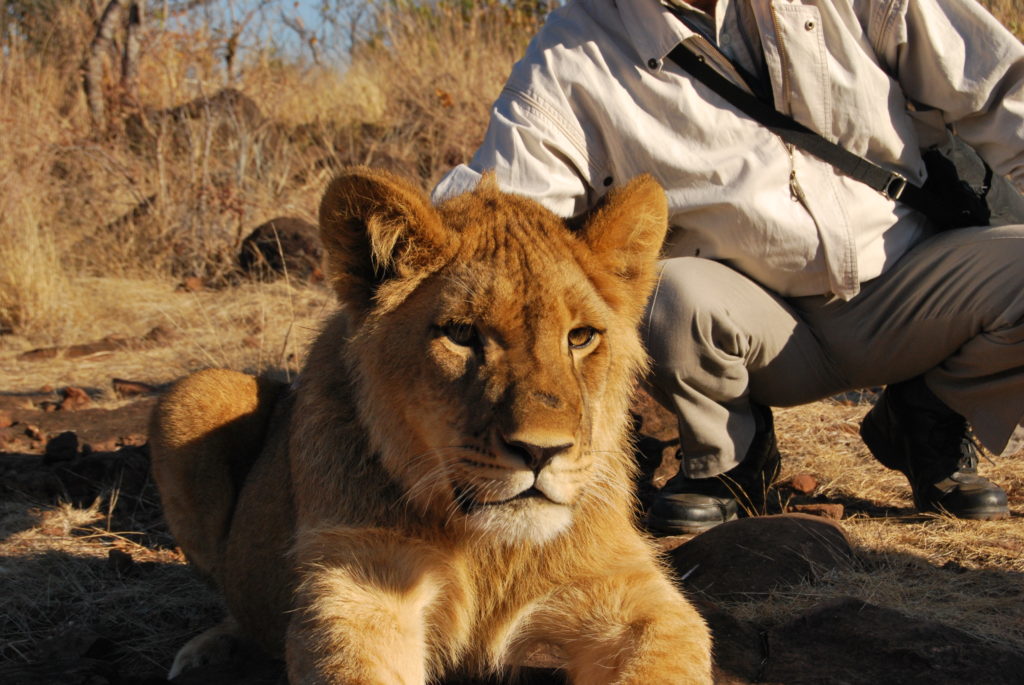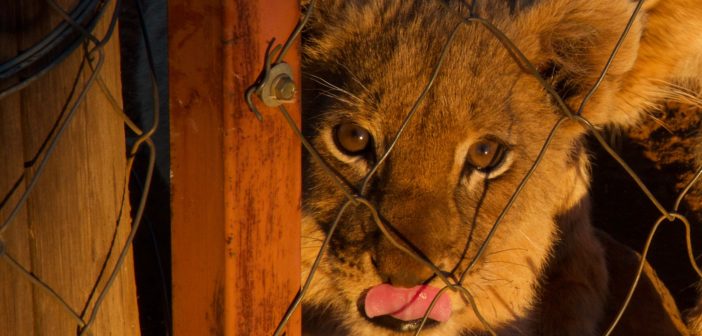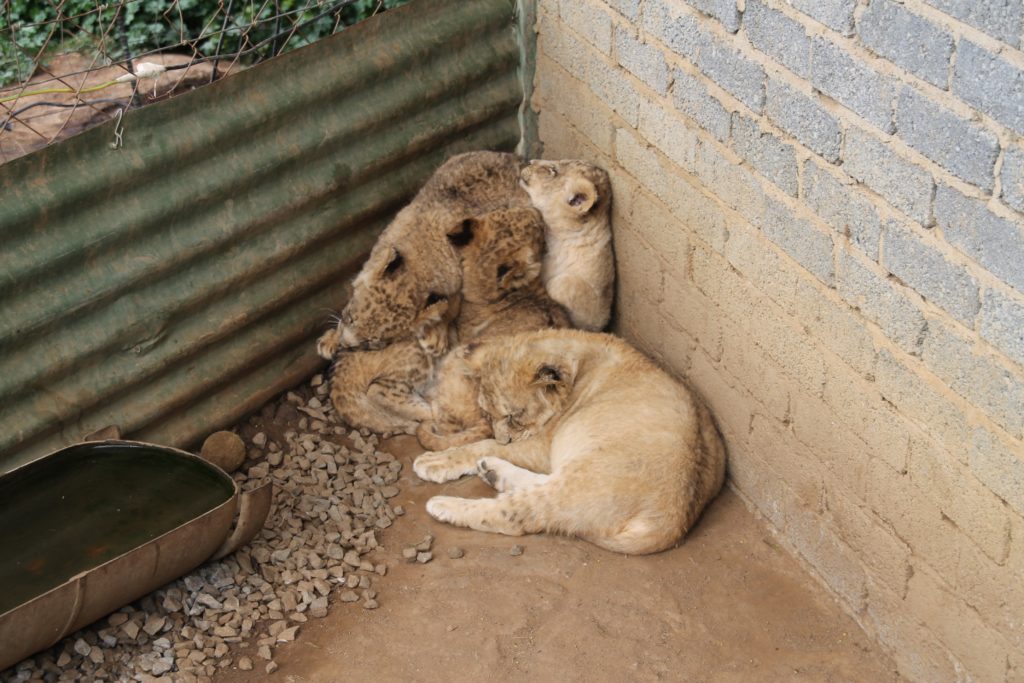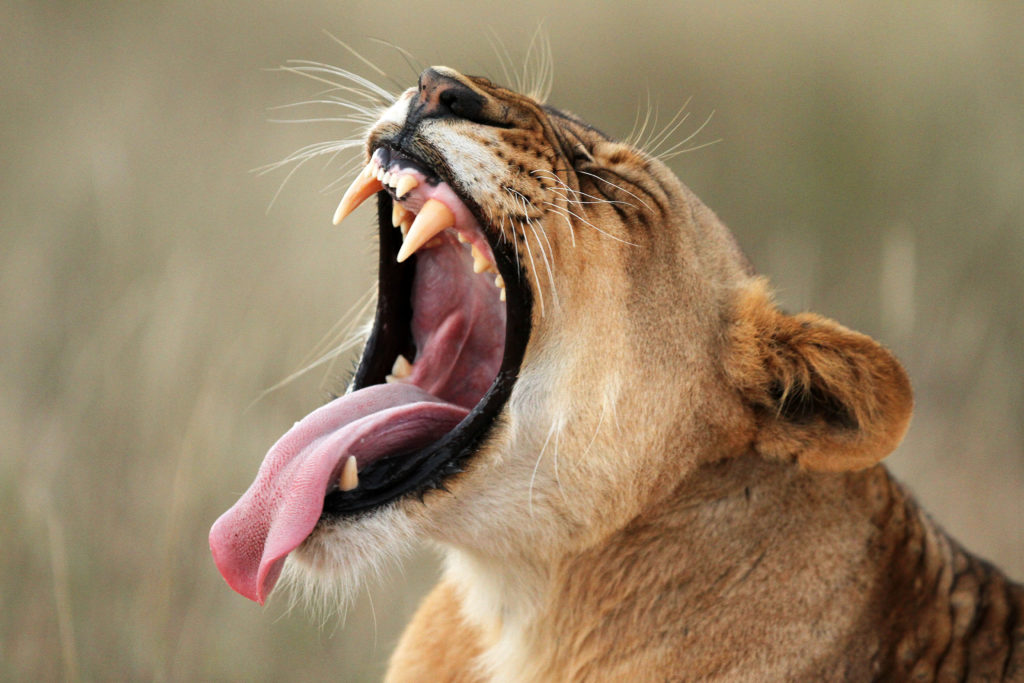South Africa’s captive lion industry is massive and exploitative, and mercilessly turns lions into profit in a number of ways. Almost anyone can open a lion breeding farm, and there are no requirements in regards to animal husbandry or welfare knowledge. Borrowing from the tactics of the meat industry’s factory farms, lionesses are subjected to constant pregnancy, with their babies often taken away after mere days, and the animals are housed in small, overcrowded spaces. These captively-bred big cats are then monetized in various ways: hunters pay to kill them and bring their trophies back home; tourists pay for “lion experiences” where they pet, walk with, or take selfies with the lions; and now their bones are also ending up in China, where they are labeled as tiger bones and sold as a Chinese medicine ingredient.
The award-winning 2015 documentary Blood Lions offered an unflinching and thorough look at this industry. It remains one of the most informative overviews of this issue, and along with the larger Blood Lion campaign of which it is a part, it has significantly increased awareness of this cruel and secretive industry. In an interview with the Blood Lions team, we discussed the issue beyond the film.
Dylan Forest: This is a really powerful film, and was very well received when it was released in 2015. The Blood Lions campaign has gone on since then. What have you been working on regarding the captive lion issue since the film’s release? What has changed in the 4 years since then?
Blood Lions team: The Blood Lions campaign was launched to create global awareness around the captive predator breeding, canned hunting and lion bone trade industries, as well as related exploitative wildlife interactive tourism practices. The campaign is anchored by the Blood Lions® film, a strong and active digital media platform, and various specific campaigns with key international partners. The campaign encourages viewers of the film, visitors to Africa and followers on social media to make responsible choices about visiting or supporting wildlife interactive tourism facilities and activities. Through awareness and by reducing demand for exploitative products, the campaign aims to bring an end to the exploitation of captive-bred wild animals.
Blood Lions has worked extensively with tourism, conservation, welfare and legal groups and has made great strides in our efforts to raise global awareness around the captive lion breeding and ‘canned’ (captive) hunting industries, as well as associated tourism activities. The Blood Lions ‘Born to Live Wild’ Tourism Campaign and Pledge has been signed by over 170 tourism operators around the world, representing close to 3,000 member organisations, who all have aligned themselves with the Blood Lions goal.
The Blood Lions® film and campaign has received over 53.6 million South African rand worth of pro bono media coverage in 4 years (approximately 3.8 million United States dollars) and the Blood Lions Facebook page reached over 3.3 million people in 2018. In addition, it has been estimated that canned lion hunting has decreased by over 50% since the film was released in 2015, which is considered a great success.
For more information on these achievements, please visit the Blood Lions campaign milestones webpage.
I think it’s an important point that a big piece of ending this trade has to take place outside of South Africa, in the countries where trophy hunters are largely coming from. The most successful example of this is the ban on importing lion trophies which was enacted in Australia in 2015. Has there been more movement on this front in other countries? Where do you think this step would be most important?
Blood Lions was directly involved in the Australian ban, which was closely followed by bans in France and the Netherlands. Another important success has been the tightening up of lion trophy import permits by the United States Fish and Wildlife Service. Although statistics still show that the majority of hunters coming to South Africa are from the United States, the import of lion trophies and body parts into America has become increasingly difficult over the last few years as a result of these measures.
Blood Lions still has initiatives underway in Finland, Sweden, the EU and the UK, seeking bans on the importation of trophies. One of the challenges we face is that governments tend to see a ban on importing canned hunting trophies as leading to a ban on all hunting trophies. Going forward, we need to get more of the conservation community involved, as well as making canned hunting a socially unacceptable issue. This will assist governments in taking action.
When we talk about a ban on the captive lion industry, the question comes up of what to do with all the lions currently living in it. Euthanasia is suggested in the film by one of the interviewees. What are your thoughts on this? What do you think should happen to these individual lions?
The best way to understand intervention is to show the historical growth of predator breeding. If the practices had been stopped when they were first exposed to the public, we were dealing with approximately 800 predators. In 2005, Blood Lions Director Ian Michler submitted a report to the South African government that estimated there were 3,500 predators in captivity. Today, that figure is likely to be over 8,000. Clearly, if we don’t act there may well be close to 15,000 in a decade to come. Bear in mind that many of these predators will be sold off in hunts and for the bone trade if any closing down announcements are made. And then some will be taken up by true sanctuaries, while others will sadly have to be euthanized.
According to lion ecologists, there have not been any successful reintroduction programs into the wild of captive-bred and hand-reared lions in South Africa. Furthermore, lion conservationists warn that captive bred lions are not suitable for ‘re-wilding,’ due to the fact that they are not only human-imprinted and have lost their fear of people, but also that most are genetically compromised and unable to fend for themselves in a fully natural habitat.
How would you respond to the argument that lion breeding is good because it results in more lions, or because it means hunters are not killing wild lions and impacting ecosystems?
The reality is that our wild lion population in South Africa is stable, at approximately 3,000 lions, and due to habitat loss this is unlikely to improve for the foreseeable future. According to the International Union of Conservation of Nature (IUCN), lions are listed as Vulnerable. Over the last decade, there have been numerous attempts at establishing a continent-wide population count, and these figures vary between 18,000 and 25,000 animals across Africa. The numbers aside, nearly all experts agree that lions have vanished from over 80% of their historic range, and they now only occur in 28 African states. Because of the rapid decline in habitat and numbers, there are some that believe lions should be afforded greater protection by upgrading their status to that of Endangered.
Internationally recognized scientists have repeatedly stated that the captive predator breeding industry has no conservation value. As mentioned previously, these animals cannot be released into the wild for a variety of reasons and, despite some of the conservation claims made by these facilities, lions offered for interactive tourism are merely parts of a very profitable revenue stream for the breeders. Very few, if any, predator breeding facilities and private lion farms in South Africa can be regarded as genuine conservation operations.
Furthermore, there is no evidence of a link between canned hunting and an increase in wild lion populations. Over the last 20 years, demand for canned and wild lion hunting has increased while the population of wild lions has decreased.
In the film you discuss that for some hunters, there is a moment where they have a realization about the animals they kill and they give up hunting. That, “for the first time, that hunter sees himself in the eye of the other.” This shift seems like a crucial part of how we get people to stop hunting and supporting hunting. Do you have thoughts on how it can be encouraged in other ways?
The ability to change human behavior and shift perspectives is one of the long term goals of the Blood Lions campaign, but unfortunately it is also one of the most difficult feats for any awareness campaign.
Ian McCullum hits the nail on the head in the film, when he talks about hunters laying down their weapons when they see themselves “in the eye of the other.” As humans, we are innately emotional beings, which is why our Blood Lions and YouthForLions campaigns constantly try to tap into those human emotions to generate positivereactions and implore people to shift their perspectives.
This can be applied to hunters, breeders and general members of the public who drive the interactive wildlife tourism industry. We aim to shift consciousness and change behaviors by educating people about what truly goes on in the captive breeding, canned hunting and exploitative interactive tourism industries. In essence, we are asking people whether it is acceptable in this day and age to breed animals in appalling conditions to have them killed by thrill-seekers as trophies.
One of the ways this trade is monetized is through tourist attractions where people can walk with lions or play with cubs, and these places often claim to be sanctuaries. How can tourists who want to make sure they aren’t funding the captive lion trade make sure they don’t go to the wrong places?

This juvenile lion is being used in interactive tourism, which is inherently cruel and should be avoided. Image credit Blood Lions.
If a facility is presented as a “sanctuary,” it is very easy to ascertain if this is correct or not by asking the right questions. A bona fide sanctuary does not breed or trade animals, nor do they allow any human interaction with their animals.
Volunteers and visitors are often told that the cubs are orphans or rescues, and that they will be released back into the wild once old enough, but this is seldom the case. This is why it is important for visitors to these facilities to ask where the cubs come from and where they will go once they reach adulthood. It is our advice to members of the public to avoid facilities that keep wild animals in captivity if that facility cannot answer these questions adequately. As is shown in the film, many don’t want to answer these questions, and become defensive when pressed.
What can people who want to help stop the captive lion trade do? What is the best focus for people in South Africa, and then those in other countries?
The best focus for people all around the world right now is to create awareness about the captive lion breeding and canned hunting industry and to prevent lion abuse. We urge members of the public to:
- Not support any breeder or operator that contributes to the cycle of breeding, exploitation and senseless killing of predators, including cub petting and “walking with lions”;
- Endorse ethical and responsible interaction with Africa’s wilderness and wild animals, thus promoting South Africa as an authentic, wild and rewarding tourism destination; and
- Support wildlife conservation and economic development across Africa by promoting the formal conservation community in their endeavors to secure the survival of Africa’s predators in the wild.
The overarching Blood Lions campaign includes two sub-campaigns, the ‘Born to Live Wild’ tourism campaign and the ‘YouthForLions’ campaign.
The Blood Lions Born to Live Wild initiative is a global tourism campaign and pledge which has been signed by over 170 tourism operators worldwide. By sending their logos to add to this Pledge, Blood Lions travel partners commit to “not knowingly book or support any breeder or operator that contributes to the cycle of breeding, exploitation and senseless killing of predators.” Tourism operators are encouraged to visit the Born to Live Wild webpage and email their commitment to the pledge to info@bloodlions.org.
The Blood Lions YouthForLions campaign is a global movement aimed at informing and engaging the world’s youth around the realities of tourist activities that exploit lions, such as cub petting and “walking with lions” attractions. We offer free presentations and screenings of the Blood Lions® film for schools and invite young people to get involved and form part of this worldwide movement! To request a presentation or screening, email the Blood Lions YouthForLions team at youth@bloodlions.org.
Another way that we encourage young people to get involved is to sign our youth pledge and commit to never pet a cub, walk with lions or support any captive breeding facility that exploits our wildlife.
People are also encouraged to watch the Blood Lions film and to visit our ‘Get Involved’ webpage for more ways to get involved and make a difference.
Featured image: a captive-bred cub behind a fence. Image © Pippa Hankinson – Blood Lions.







